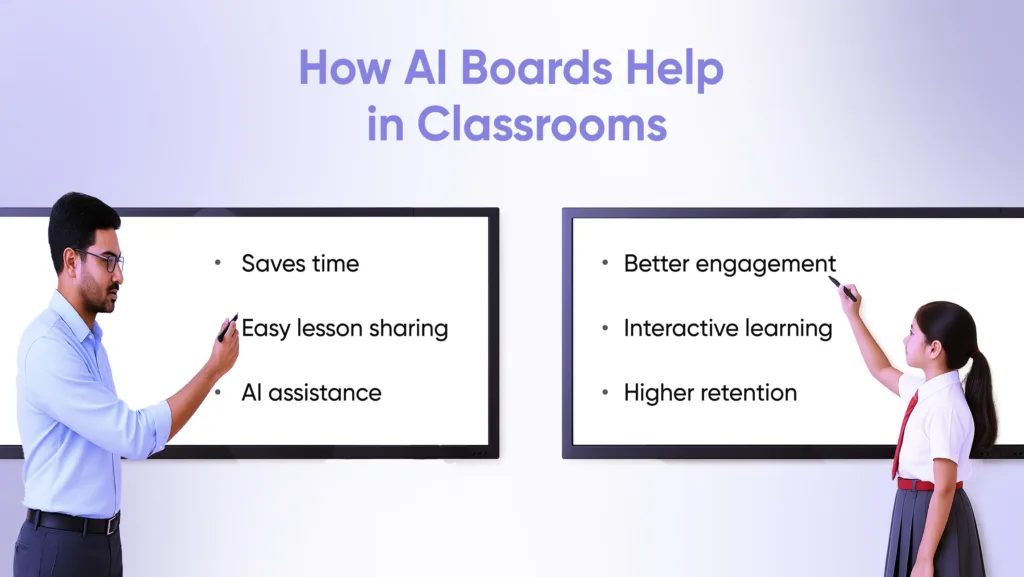Teaching methodologies are changing quickly, and learning environments today require more than chalkboards and whiteboards. An electronic board for teaching is a new development that enhances classroom instruction by promoting interactivity, visual appeal, and school-wide engagement for students.
The rise in AI digital boards also provides effective lesson planning, smart teacher aids, and unparalleled student engagement. The easy-to-use learning boards offer touch-screen technology, multimedia support, and easy-to-use AI, designed to make learning easy and effective.
👉 Senses Electronics produces advanced AI-powered digital boards designed to turn classrooms into future-ready learning environments.
Key Takeaways:
- In-person classroom teaching tools are being replaced by electronic boards.
- AI digital boards enhance teaching values with lesson planning features, student engagement, and collaborative features.
- Digital boards have advantages for teachers, students, and educational institutions.
- Senses Electronics offers AI-powered digital boards of the highest quality in India.
What is an Electronic Board for Teaching?
An electronic interactive board is a digital display device, which teachers and students can use to write, draw on, highlight, and interact with directly on a screen using the stylus or touch. These boards are different from traditional whiteboards, which are simply a white surface that uses markers and erasers to write and draw on, with little to no interaction with it.
Instead, electronic boards allow:
- Multi-touch interaction.
- Multimedia integration (videos, presentations, images).
- Real-time collaboration.
- AI-enhanced teaching aids.
Clearly, these boards are much more efficient and productive for classrooms of the future.
Evolution Toward AI Digital Boards
The movement from blackboard to whiteboard to smart board and now to AI digital board reflects the evolution of teaching technology. Schools are switching to an AI digital board because they help teachers with planning lessons, individualising instruction, and engaging students.

AI Digital Board for Teaching
AI digital boards leverage artificial intelligence and smart board technology to facilitate more efficient, quicker, and interactive teaching.
1. AI-Assisted Learning Resources
Several AI features, like handwriting detection, speech-to-text, and automatic recording, help teachers save time. For example, a teacher can write on the board, and the board will automatically convert the writing into perfectly typed notes in the background for editing.
2. Digital Board Lesson Planning Features
Many of today’s digital boards for teaching have lesson planning features that let teachers:
- Access pre-prepared templates.
- Store notes and resources for each subject.
- Access past lessons easily.
- Pull in digital resources like diagrams and videos in the lessons.
- This streamlines lesson preparation time greatly.
3. Electronic Board Student Engagement
AI digital boards support students’ engagement by using various interactive features like quizzes, mini games, polls, or live question-answer features. This encourages students to stay attentive and learn better than they would with non-interactive forms of teaching.

Traditional vs AI Digital Board
Though traditional boards are capable of serving their intended purpose, AI digital boards will unquestionably lead in the future of interactive instruction.
1. Cost and Value Considerations
Traditional boards seem cheap at first glance, but they are continually consuming chalk, markers, and so on. AI boards are more expensive initially but end up saving money over time from the faceted reductions in printing, books, and physical resources.
2. Teaching Efficiency
Teachers can teach more efficiently due to the teaching and learning capabilities of AI features, such as:
- Automatically generated summaries.
- Notes that can be instantly saved.
- More efficient access to web resources to augment learning in real-time.
- Teaching will be much easier and faster.
3. Student Engagement & Learning Outcomes
Chalkboard benefits are limited to drawings and notes, whereas with an AI board you can incorporate videos, animations, and interactive opportunities. Students will remember and learn more and achieve better results.
Comparison Table: Traditional vs AI Digital Board
| Feature | Traditional Board | AI Digital Board |
| Writing Style | Chalk/Marker | Touch/Smart Pen |
| Multimedia Support | No | Yes (Video, Audio, 3D) |
| Student Engagement | Low | High (Interactive tools) |
| Lesson Saving | No | Yes (Cloud & Local) |
| Cost Efficiency | Short-term only | Long-term ROI |
Key Features of an Electronic Interactive Board
Electronic interactive boards are equipped with functions that are especially constructed to enhance contemporary teaching and learning.
1. Multi-touch and Smart Writing
These boards can accommodate multiple users at the same time, which provides for group activities, message brainstorming and interactive activities. Teachers can also write during instruction with a stylus or finger, providing additional versatility.
2. Interactive Classroom Whiteboards
A dynamic session can be created by connecting an interactive whiteboard to a device, like a laptop, tablet, or projector, which sets it apart from a static whiteboard or chalkboard. Interactive classroom whiteboards also facilitate remote learning and interaction with students in a hybrid instructional learning model.
3. Smart Board Collaborative Learning
Students can share their completed work directly from their devices onto the board, work collaboratively in real-time, and participate in group projects. The functionality of a smartboard fosters teamwork and creates excitement for participation in a teaching practice.
Benefits of AI Digital Boards for Teachers and Students
Digital boards using AI offer unique advantages for educators, students, and institutions.
1. For Educators
- Make preparation more efficient via digital lesson planning.
- Have on-demand access to teaching aids.
- Record and share lessons in order to access them later.
2. For Students
- Learn with charts, multimedia, and visual aids.
- Participate in gamified lessons, polls, and quizzes.
- Use interactive sessions centred on small group discussions to break up the conventional lecture format.
3. For Schools & Institutions
- Support their mission as institutions that use technology to any extent.
- Grow enrollment by demonstrating smart classrooms.
- Reduce costs over time by eliminating books and printed resources.

Applications of AI Digital Boards Beyond Schools
AI boards are not restricted solely to education; they are prevalent in many professions and levels of education.
- Corporate Training Facilities: Corporations utilise them for employee professional development, brainstorming, and interactive presentations.
- Coaching Institutes: Coaching organisations can utilise the digital boards in a classroom to demonstrate problem-solving in real-time, facilitate demonstration classrooms, and record lectures.
- Postsecondary Education & Universities: Higher education universities utilise the AI boards for hybrid classrooms, conducting research discussions, and facilitating group projects.
Why Choose Senses Electronics for Electronic Boards?
Senses Electronics is one of the brands that you may consider if you are looking into AI-enabled electronic boards in India.
Senses Electronics offers its SenseTeam AI Interactive Boards that come with:
- 4K ultra HD clarity for clear resolution
- AI-assisted features like handwriting recognition and voice command capabilities
- Multi-touch collaboration for interactive learning
- Lesson recording and sharing capabilities
- Energy-efficient sensors to save on costs
Conclusion
Technology-driven classrooms represent the future of education. Electronic boards for teaching are reshaping education as it exists today, and AI digital boards represent the next step forward in this educational evolution. They make teaching easier, increase student engagement, and promote collaborative learning environments.
If you are an educator or educational institution, there is no better time to explore options to upgrade.👉 Check out Senses Electronics AI-powered interactive boards and bring the future of education to your classrooms.
FAQs
An electronic board is essentially a digital whiteboard, while an AI digital board incorporates artificial intelligence to enhance the features of lesson plans, handwriting recognition, and interactive tools for teaching.
Yes, electronic interactive boards can be used in any context that involves instruction, such as schools, colleges, and coaching centres, as well as training rooms.
An AI digital board facilitates engagement (interaction) with quizzes, lessons (new to this context), and gamification of learning that keeps students engaged (interested).
The sales point is based on the smart board being included with newer, AI smart features; being durable in a classroom; and being a solution or support for the classroom.

